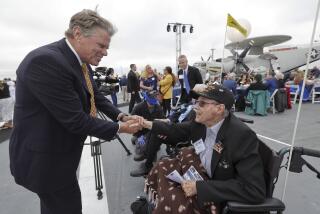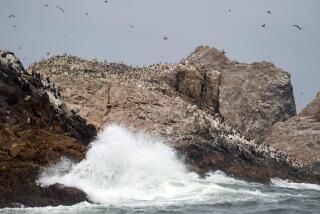A Backward Turn for Midway
When Navy Lt. Bill Shoemaker, the officer in charge at Midway, boards a plane today to leave for the last time, he’ll be closing the book on nearly a century of American military presence on the Pacific atoll group, celebrated for its role in the Battle of Midway, the turning point for U.S. forces in the Pacific in World War II. Now with the Cold War over, Midway will once again become a strategic landing site only for gooney birds.
Midway is taking on a new role as a protected refuge under management of the U.S. Fish and Wildlife Service of the Department of Interior. An effort to restore the atolls to a near-pristine state has become a unique experiment in public-private eco-management. A Georgia company is managing controlled tourist and research visits.
The No. 1 mission on Midway now is protection of 15 species of migratory seabirds, plus the endangered Hawaiian monk seals and green sea turtles that live in Midway’s waters. The group of islands contains the world’s largest colony of Laysan albatross, better known as the gooney bird.
The Navy air facility at Midway was “operationally closed” in 1993 in preparation for a $60-million environmental cleanup before the transfer to the Fish and Wildlife Service. Washington has had jurisdiction over the atolls since 1867 when Capt. William Reynolds of the U.S. ship Lackawanna took possession, making Midway, located almost halfway between Japan and the United States, the first offshore island group annexed by the United States. The Navy imposed military control in 1903 because of complaints about Japanese squatters and poachers. The first around-the-world cable message, which took nine minutes, was sent via Midway.
But Midway is best known for the U.S. naval victory over the Japanese fleet in the June 4-6 battle in 1942. The U.S. military learned of Japan’s attack on Midway by breaking the Japanese code. Four Japanese aircraft carriers were destroyed north of the atolls, and the loss changed the course of the war in the Pacific. In later decades, as many as 3,000 American service personnel were stationed at Midway at a given time. President Richard Nixon and South Vietnam President Nguyen Van Thieu conducted meetings there in June 1969.
Today the population of Midway is fewer than 300, mostly Sri Lankans, Filipinos and Thais working as cooks, mechanics and caretakers. Bicycles are the No. 1 mode of transportation and the wildlife has the right of way. Research projects are underway, including a study of lead-based paint poisoning of gooney chicks. Another threat to the birds lies in the plastic bottle tops and other foreign materials that the parents scoop up as they feed on the surface of the Pacific; the substances are transferred to their chicks by regurgitation. Midway survived a Japanese onslaught, but the question now is whether its main inhabitants, the gooney birds, can survive on a diet that includes plastic.
More to Read
Sign up for Essential California
The most important California stories and recommendations in your inbox every morning.
You may occasionally receive promotional content from the Los Angeles Times.









